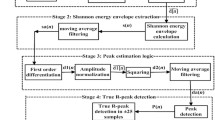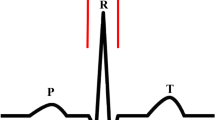Abstract
The QRS complex in an electrocardiogram reflects the activity of the cardiac ventricles. Cardiac ventricle activity can provide information about ventricular arrhythmia. This study investigated whether the dominant activity of the ventricles can be used to analyze ventricular arrhythmia characteristics. To assess ventricular activity, we modified the adaptive threshold method proposed by Shin et al. and developed a ventricular activity segmentation approach. The proposed method was tested using five cardiac episodes, namely normal sinus rhythm, supraventricular tachycardia, ventricular tachycardia, ventricular flutter, and ventricular fibrillation, obtained from the MIT-BIH and Creighton University Ventricular Tachyarrhythmia databases. The average sensitivity was 95.77 %, the average positive predictivity was 98.09 %, and the average failed detection rate was 6.08 %.





Similar content being viewed by others
References
Kohler, B. U. (2002). The principles of software QRS detection. IEEE Engineering in Medicine and Biology, 21, 42–57.
Pan, J., & Tompkins, W. J. (1985). A real-time QRS detection algorithm. IEEE Transactions on Biomedical Engineering, 32, 230–236.
Ferdi, Y., Herbeuval, J. P., Charef, A., & Boucheham, B. (2003). R wave detection using fractional digital differentiation. ITBM-RBM, 24, 273–280.
Legarreta, I. R., Addison, P. S., Grubb, N., Clegg, G. R., Robertson, C. E., Fox, K. A. A., & Watson, J. N. (2003). R-wave detection continuous wavelet modulus maxima. Computers in Cardiology, 49, 565–568.
Fraden, J., & Neuman, M. R. (1980). QRS wave detection. Medical and Biological Engineering and Computing, 18, 125–132.
Holsinger, W. P., Kempner, K. M., & Miller, M. H. (1971). A QRS preprocessor based on digital differentiation. IEEE Transactions on Biomedical Engineering, 18, 212–217.
Hamilton, P. S., & Tompkins, W. J. (1986). Quantitative investigation of QRS detection rules using the MIT/BIH arrhythmia database. IEEE Transactions on Biomedical Engineering, 33, 1157–1165.
Ma, J., Shi, C., Zhang, Z., Zhu, J., Zhan, P., Fan, Y., Li, D., & Wang, L. (2014). A differentiation-based adaptive double threshold method for real time electrocardiogram R peak. Proceedings of International Conference and Biomedical Engineering Information, 3, 259–263.
Chouakri, S. A., Reguig, F. B., & Ahmed, A. T. (2011). QRS complex detection based on multi wavelet packet decomposition. Applied Math and Computation, 217, 9508–9525.
Mukhopadhyay, S., Biswas, S., Roy, A. B., & Dey, N. (2012). Wavelet based QRS complex detection of ECG signal. International Journal of Engineering Research and Applications, 2, 2361–2365.
Pal, S., & Mitra, M. (2010). Detection of ECG characteristic points using multiresolution wavelet analysis based selective coefficient method. Measurement, 43, 255–261.
Bouaziz, F., Boutana, D., & Benidir, M. (2014). Multiresolution wavelet-based QRS complex detection algorithm suited to several abnormal morphologies. IET Signal Process, 8, 774–782.
Slimane, Z. E. H., & Ali, A. N. (2010). QRS complex detection using empirical mode decomposition. Digital Signal Process, 20, 1221–1228.
Pal, S., & Mitra, M. (2012). Empirical mode decomposition based ECG enhancement and QRS detection. Computers in Biology and Medicine, 42, 83–92.
Zong, W., Moody, G. B., & Jiang, D. (2003). A robust open-source algorithm to detect onset and duration of QRS complexes. Computers in Cardiology, 30, 737–740.
Chouhan, V. S., & Mehta, S. S. (2008). Detection of QRS complexes in 12-lead ECG using adaptive quantized threshold. International Journal of Computer Science and Network Solutions, 8, 155–163.
Ravanshad, N., Rezaee-Dehsorkh, H., & Lotfi, R. (2014). A level-crossing based QRS-detection algorithm for wearable ECG sensor. IEEE Journal of Biomedical and Health Informatics, 18, 183–192.
Sun, Y., Chan, K. L., & Krishnan, S. M. (2005). Characteristic wave detection in ECG signal using morphological transform. BMC Cardiovascular Disorders, 5, 28–34.
Xue, Q., Hu, Y. H., & Tompkins, W. J. (1992). Neural-network-based adaptive matched filtering for QRS detection. IEEE Transactions on Biomedical Engineering, 39, 317–329.
Mehta, S. S., Shete, D. A., Lingayat, N. S., & Chouhan, V. S. (2010). K-means algorithm for the detection and delineation of QRS-complexes in electrocardiogram. IRBM, 31, 48–54.
Abibullaev, B., & Seo, H. D. (2011). A new QRS detection method using wavelets and artificial neural networks. Journal of Medical Systems, 35, 683–691.
Dubin, D. (2000). Rapid interpretation of EKG’s (6th ed.). Hong Kong: Cover.
Israel, S. A., Irvine, J. M., Cheng, A., Wiederhold, M. D., & Wiederhold, B. K. (2005). ECG to identify individuals. Pattern Recognition, 38, 133–142.
Papaloukas, C., Fotiadis, D. I., Likas, A., Liavas, A. P., & Michalis, L. K. (2000). A robust knowledge-based technique for ischemia detection in noisy ECGs. Proceedings of International Journal of International Conference on Knowledge-Based Engineering System and Allied Technology, 2, 768–771.
Allstot, E. G., Chen, A. Y., Dixon, A. M. R., Gangopadhyay, D., & Allstot, D. J. (2010). Compressive sampling of ECG bio-signals: Quantization noise and sparsity considerations. IEEE Biomedical Circuits and Systems Conference, 18, 41–44.
Shin, H. S., Lee, C., & Lee, M. (2009). Adaptive threshold method for the peak detection of photoplethysmographic waveform. Computers in Biology and Medicine, 39, 1145–1152.
Acknowledgments
This research was supported by the Ministry of Education (MOE) and National Research Foundation of Korea (NRF) through the Human Resource Training Project for Regional Innovation (Grant No. 2011H1B8A2003304).
Author information
Authors and Affiliations
Corresponding author
Rights and permissions
About this article
Cite this article
Lee, S.H., Yoon, Y.R. Method for Detecting Ventricular Activity of ECG Using Adaptive Threshold. J. Med. Biol. Eng. 36, 410–419 (2016). https://doi.org/10.1007/s40846-016-0134-z
Received:
Accepted:
Published:
Issue Date:
DOI: https://doi.org/10.1007/s40846-016-0134-z




